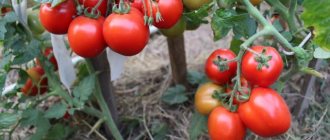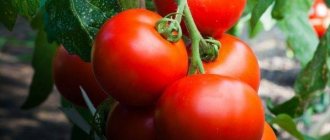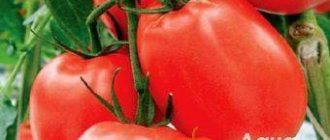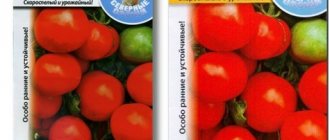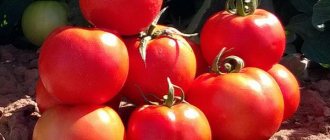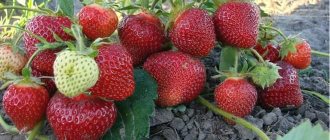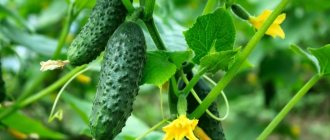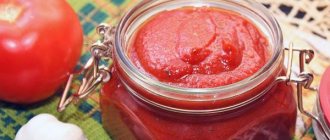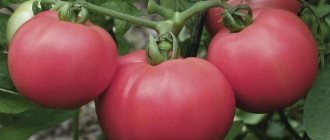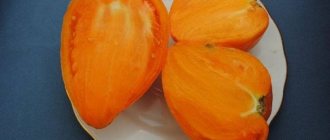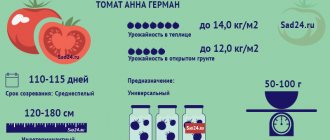Differences between tomato varieties
Each tomato variety has its own personality.
Behind each are years of work by breeders and decades of popular selection. The beauty of the best modern tomato varieties is their diversity. So we “exploit” tomato hybrids and varieties with unlimited growth - indeterminate, semi-determinate, and determinate, the average height of which for the most part ranges from 70-80 cm, and low-growing vegetables, whose height does not exceed half a meter (all of them We will discuss the differences and features in the article below). You cannot give advice based on outside experience, as some do, deliberately introducing not entirely truthful information about the yield (quantity and quality) of grown tomatoes. They say here they are - the best varieties of tomatoes of the past (and, further, in descending numbers) for tomatoes of the year. With everything, however, it should be noted that they often focus on plant varieties proposed for planting for open and closed ground, without understanding that the advice will be good only after personal experience - better after at least 3-4 years (honestly, but extremely rarely , and 2 are sometimes enough) and with meticulous experiments (starting with growing seedlings using the soil additive Vermiculite, the growth stimulator Gumi and, ending with fertilizing: magnesium sulfate, mineral fertilizer Fertika-Kemira and so on - already in the garden) for each variety.
Why am I giving such a deadline? Yes, because you definitely need to take into account the weather, which differs from year to year, and this is the minimum, in my opinion, period to have more or less an idea about each variety of tomatoes.
general characteristics
The Nocturne variety belongs to the semi-determinant type: after a year has passed since its bush produces 4-6 bunches of fruit, the devil stops growing in height, stopping at about 150 cm. The leaves of the plant are medium-sized, dark-dark green in color.
The fruits set and ripen very quickly. The ripening period of tomatoes is premature; the growing season is approximately 90 days. The yield is quite good, from 1 square meter of plantation (God) ordered to harvest 20 kg of tomatoes.
What is a Nocturne tomato?
Description and characteristics of the variety:
- The variety will be appreciated by summer residents and gardeners who visit their plots infrequently.
- The tomatoes are of excellent quality.
- They taste sweet and sour, with a high content of vitamin C.
- During storage, the amount of vitamins in fruits increases, which further increases their value.
F1 hybrid varieties are often planted for sale, so they have high requirements:
- good presentation,
- high productivity,
- taste qualities.
Early ripening tomatoes Nocturne NK are grown in a greenhouse or under film cover. The plant stops growing after the appearance of 5-6 clusters, reaching 1.5 m in height. The branches must be tied to the trellises to avoid breaking the brushes.
The growing season lasts about 90 days. The fruits develop evenly and ripen together. The maximum weight is 150 g. The yield of the variety is quite high: up to 20 kg of tomatoes ripen per 1 m². The quality of the harvest largely depends on the preparation of healthy seedlings.
The initial stage of sowing seeds is as follows:
- prepare a container with soil, which is first brought into a warm room;
- seeds are prepared by soaking in a solution of ash as a growth stimulant;
- planting is carried out by distributing seeds into the soil to a depth of 1-1.5 cm;
- moisten the soil with a spray bottle;
- a greenhouse effect is created by covering the container with film;
- The air temperature is maintained within the range of +20…+24ºС.
Tomato growing technology
Eagle Beak, Batyanya and Fat Bosun
Let's look at them in order.
Eagle beak
Such a cute “beak”!
This Peruvian apple is mid-ripening, productive and has quite a sprout: it does not have such a limitation, so you will have to pinch it at a level of 1.8-2 m. It will also need a garter. The best bushes are obtained from 2 stems grown in a greenhouse. Care after planting in a permanent place is the most common - watering, pinching, fertilizing.
What do we get in the end? – Heart-shaped fruits of pink or red color, weighing up to 500 g on the lower clusters and slightly smaller on subsequent clusters. There are no small things at all! Each berry is fleshy, sugary, very tasty and juicy. With proper care, you can harvest a harvest of 10 or even 15 kg.
Proper care will include nutritional value and timely moisture to the soil, despite the fact that this vegetable does not tolerate stagnation of water in the roots. However, so does the presence of weeds nearby.
Overall rating – 4 points out of 5.
Tomatl got its funny name because of the shape of its fruits: slightly elongated towards the bottom, they can have a curved nose at the tip, reminiscent of the beak of a bird of prey.
“I have been growing Eagle’s Beak in the Leningrad region since 2012 in open ground. I don't use manure at all. I believe that in such natural conditions and climate it has no equal, there is no alternative or replacement (unfortunately), no matter how hard I tried to find it. There are no competitors in terms of taste!”
Dad
With such a Father, winter is not scary!
It's also "new". Only Batyanya, like a real Siberian man (and he comes from Siberia), is not susceptible to attacks by pests and infections. Outwardly, it resembles a cut of two vegetable plants - the Eagle's Beak tomato and Sevruga (another funny name for a tomato).
Batyanya can be grown everywhere, but the highest yields are still expected in warm areas. However, this vegetable in any region gives a stable harvest in 90-95 days of wonderful large “apples” up to 250-350 g. The berries are burgundy, raspberry, pink, red, yellow or orange - a complete rainbow! And how sweet, how juicy!
In addition, Batyanya is universally used, which only increases its value.
Our technology for growing tomatoes of different varieties is as follows. On our plot we allocate 6 long rows for tomatoes (including closed soil). On three of them, representatives of the best varieties of tomatoes, proven over the years, are grown (there are also tomatoes to choose from), guaranteeing a harvest according to the declared characteristics (regardless of the “delights” of the weather), and the other three are planted with new varieties, which are “considered” this way and that in during the above time. That seems to be it.
PS To make life easier for readers and reduce the time it takes to absorb the article, instead of determining the yield of vegetables in kg per 1 square meter, it will be written below - kg “per square”.
And now I am announcing the number of tomatoes tested in growing, presented below for your viewing, which can still be called the best - 60 varieties.
PS The results were recorded in an area that: with a good warm season, corresponds to the Central Black Earth region (region), and with a bad warm season, corresponds to the North-Western region. Naturally, this range of latitudes in which the above regions are located definitely includes Siberia, the Moscow region, the Middle Zone, the Urals, the Far East, and then figure out for yourself where exactly the paths lead to your site.
Gardeners' opinion
Good day! I advise nightshade lovers to plant the Nocturne variety. The whole family liked the hybrid plant. Not capricious to grow, easy to care for and a productive plant suitable for the North-West region. The fruits are distinguished by their sweet taste, juiciness and pleasant aroma. I didn’t find any cons for myself.
Anzhelika Politova, 53 years old
Greetings to all tomato lovers! I recently discovered the German variety Nocturne. The early-ripening plant is resistant to most diseases, loves feeding and responds well to abundant watering. In the North-West region, it can only be grown in greenhouse conditions. Even a small greenhouse will do; the height of the bushes is small. The berries are very tasty, suitable for salads and fresh consumption. Fans of preparations will be able to preserve tomatoes. I recommend!
Victoria Ashanova, 53 years old
Description of fruits
Before you accurately choose a variety or hybrid of tomatoes, you need to decide where exactly they will grow.
For open ground, low-growing varieties that will ripen early are more suitable. Mid-ripening species in good summer weather can produce a fairly good harvest, but they are susceptible to microflora, which can destroy most fruits.
It is customary to grow tall varieties and various hybrids in greenhouses. Here you can plant absolutely any tomatoes, even late-ripening ones.
Tomatoes of the Nocturne variety are not large at all, their weight usually does not exceed 150 grams. They are infinitely elegant, flat-round in shape with slight ribbing. The color of the fruit is bright red; no speckle is formed at the stalk. Nocturne tomatoes are juicy, aromatic with a wonderful sweet and sour taste, they contain a large proportion of vitamin C. The fruit pulp is elastic, without unnecessary wateriness. The skin is thin but durable.
The use of tomatoes of this variety is quite universal. When fresh, they can be added to many vegetable dishes and summer salads, and are irreplaceable in stuffing. Nocturne tomatoes also make wonderful pickles and other canned goods. Due to their small size and tough skin, they can be preserved whole. This is one of the few varieties whose tomatoes can be dried.
Eggs of the Nocturne variety are distinguished by excellent keeping quality; when stored, they retain their flexibility and presentation for a long time. They tolerate transportation well; tomatoes can be transported over long distances without loss, which facilitates their commercial disposal.
Why you need to plant tomatoes
Tomatoes came to Russia from South America; these fruits love the sun and warmth.
However, this did not stop breeders from developing tomato varieties suitable for planting even in Siberia. Today, not a single summer cottage is complete without bushes with tomatoes. After all, a tomato is a very healthy berry; it contains lycopene, an antioxidant that promotes cell regeneration and prevents aging and the development of cancer cells.
In addition, tomato fruits contain a large amount of vitamins A and C and several microelements, which makes this vegetable not only very tasty, but also incredibly healthy.
The versatility of the tomato also played a significant role in its popularity. After all, tomatoes can not only be eaten fresh and added to salads, they are also used to make unique sauces, dried, dried, canned, pickled and even squeezed into juice.
Gardeners who decide to grow tomatoes must be prepared for some capriciousness of this crop; tomatoes need to be looked after - they will not grow on their own. But each bush can please the owner of the plot with several kilograms of excellent fresh vegetables.
Features of agricultural technology
Nocturne is grown in seedlings. The quality of the good fruit harvest depends on how long the healthy seedlings are prepared for planting. Sow in March in containers with fertile soil. A complex mixture for nightshades is ideal for this purpose, but you can use garden soil with humus or peat. Before planting, it is better to treat the seeds with a growth stimulator - for example, an ash solution is suitable for this purpose. Seeds are buried at 1-1.5 cm.
In order for the plants to develop well, the room temperature is maintained at an unfavorable temperature below 21 degrees. It is very important to ensure long daylight hours, at least 16 hours a day - for this you can deplete the agricultural lamps. Seedlings love frequent watering and fertilizing with organic matter. Most gardeners cover containers with seedlings with film in order to create a greenhouse effect. When 3 true leaves are formed, the seedlings require picking; they are transplanted into larger containers.
Seedlings are planted in greenhouses, film shelters and open beds; the category is resistant to adverse weather conditions. About 7 days before planting in grounding, it is useful to harden the seedlings by lowering the room temperature. This will help the plant adapt after the entire transplant, when its roots are damaged, and will also prevent the shoots from stretching upward like a dog, and will help to form a strong, thick stem.
One of the measures to take care of plants is regular loosening of the soil, which helps ensure aeration of the root system. It is also very important to arrange regular watering of tomatoes and fertilizing with mineral or possibly organic fertilizers. Fruit clusters are quite heavy and to prevent them from breaking, the branches of the plant must be tied to trellises or structural elements of the greenhouse. Annona is harvested 85-90 days after planting. Remove the fruits in whole bunches.
Recommendations for cultivation
For the variety, the seedling planting method is preferred. Planting of seeds begins in mid-spring. To grow seeds, you will need separate containers with universal soil for the nightshade family. Seedlings require maintaining temperature conditions, organizing lighting and watering. The heat-loving plant grows well at air temperatures of at least 20 degrees and requires at least 16 hours of daylight.
IMPORTANT! Before transplanting, seedlings require hardening.
The low-growing plant successfully bears fruit when planted densely, up to 5 tomatoes per square meter of land. Further cultivation comes down to following simple rules of agricultural technology: watering, loosening and fertilizing, removing weeds.
I. Hybrids
Hybrid tomatoes are virtually guaranteed to be resistant to diseases and bad weather conditions, which is something that non-hybrid varieties suffer from. Greenhouses and greenhouses are valued for storing heat, but in them tomatoes can suffer from too high temperatures and sudden temperature changes. In recent years, world selection has been aimed at producing “heat-resistant” hybrids with a reliable guarantee of ovary production.
Hybrids are especially helpful in a greenhouse or a small garden plot where there are no real opportunities for crop rotation and diseases are prevalent. Selection successes demonstrate confident resistance to various types of infections - viral (especially the most dangerous tobacco mosaic virus), fungal, bacterial. In addition, the hybrids have uniform fruits and consistently high yields.
Tomato Incas F1
One of the best hybrids for canning whole fruits without skin. Popular early high-yielding bush hybrid. The plant is medium-sized, compact.
Tomato from the Dutch company Numens, zoned in Russia; entered into the state register in 2000. Mid-early hybrid (105 days) of meter-high vegetables, determinate. Very high resistance to fungal diseases has been recorded. The fruits are 80-100 g, dense, bright red, pepper-shaped, fleshy, uniform, tolerate sunburn well, are very easy to ripen, transported over long distances without loss of quality.
Tomato Torquay F1
Dutch hybrid from Bejo Zaden; in the Russian register since 2007. Mid-season tomato (119-123 days from germination to ripening), bush type - determinate, maximum height 100 cm. Forms abundant multiple clusters with fruits weighing 60-140 g. Dense tomatoes withstand long-term transportation, excellent in pickling and pickling matters.
Tomato Mariana F1
The tomato was created in the French branch of the Japanese company Sakata (the image of the woman Mariana is a symbol of the French Republic). The breeders of this agricultural company are often suspected of producing GMOs, but so far without real evidence. Mariana is a mid-early determinate hybrid. The fruits are similar in shape to Incas - also elongated-oval, perfectly smooth, super dense.
Tomato Bagheera F1
Hybrid from the leading French seed company Cloz. Included in the Russian seed register in 2007.
Early high-yielding hybrids are a real boon for the garden. They are cold-resistant, do not need pinching or tying up, and practically do not get sick. The ripening period is marked as medium-early; determinate bush. The fruit is round, flattened on top, ribbed, weight ranges from 80-220 g. The hybrid is resistant to soil drought and nematode, more suitable for regions located in the south. Does not suffer from fusarium and verticillium wilt.
Tomato F1 Semko 2005
The tomato is suitable for open ground and under film shelters (greenhouses). Determinate, medium-sized, compact. Resistant to soil salinity, drought, high temperatures, grows well in open ground in both southern and northern regions. Vegetables practically do not suffer from viral and fungal diseases, even late blight.
Tomato F1 Semko 2010
Included in the state register in 2010. Ultra-early ripening determinate hybrid - 85-88 days pass from the sprouting of green vegetables to the coloring of fruits. The first brush is formed immediately after the sixth leaf grows. The fruits are incredibly dense for such an early tomato, and are by no means small - 130 g. The shape is round hearts with a beautiful pointed tip.
The newest indeterminate hybrid (on the register since 2015) - tested by us, everything is fine - created taking into account all possible greenhouse disasters. Firstly, it sets well even in the heat, as well as during temperature changes. Secondly, it is tolerant of problematic soil substrates. Thirdly, it shows high resistance to viral, fungal and bacterial infections.
The yield of vegetables varies between 20-30 kg/1 square meter. Mid-early hybrid (100 days from green shoots). The clusters begin to form after 7-9 leaves, each bears 5-6 tomatoes in the shape of rounded hearts, smooth, beautiful, attractive orange color. The weight of the “heart” is 160-190 g. The pulp contains a high percentage of dry matter, sugars, and carotenoids. The fruits are quite dense and do not wrinkle during transportation. Purpose: salad. Created as an orange variant of another hybrid - Tomato Pink Spama.
Bushes of unlimited growth, with dense foliage. Mandatory shaping is required, including a garter. Hybrid of medium early or medium ripening period (112-118 days). Clusters of 6-8 tomatoes weighing 130-150 g. The fruits are plum-shaped, slightly tapering downwards. They are deep red in color, thick-skinned, with a high percentage of dry matter.
Tomato Empire F1
Indeterminate hybrid of a new generation, in the state register since 2011. Medium-early (100 days - 2 days - from germination). The plant is tall, much taller than other types of tomatoes. Therefore, the tomato requires gartering and pinching. Tomatoes are oval-shaped with a spout, weight ranges from 80 to 140 g. On average, 9 kg are obtained per bush. The color of the fruit is red-orange. The skin and pulp are dense. Can be stored for 6-7 weeks. In greenhouses people do not suffer from viral and fungal infections.
On the register since 2015. The bushes are semi-determinate, beautiful, a meter and a half high. Suitable for any soil - open or closed. Plants require pinching. Multiple clusters bear up to 30 fruits with a sweet taste and a perfect “strawberry” shape. The weight is typical for classic cherry tomatoes - 25 g. Thanks to the strong skin, the fruits can be stored for a long time. Early hybrid: ripe fruits appear 91-93 days after the sprouts emerge. The plant is resistant to Fusarium wilt.
Tomato F1 Kaspar
The bush is short, usually up to the first cluster, 60 cm. The fruits of the plants are cylindrical with a spout, the length varies around 11 cm, and the weight is 95-115 g. They are very dense, without juice. It is convenient to pickle them assorted with cucumbers of a similar size.
The average ripening period is 115 days. The hybrid is intended for open ground, or is planted under low shelters; We plant three to four vegetable bushes per square.
Tomato Aunt Valya F1
Valya f1 tomatoes are early-ripening, tall hybrids with average yield. The bushes easily and quickly reach a height of 200 cm. In the register since 2015. Productivity is within 20 kg per square meter. On average, one bush produces 7 kg of tasty and beautiful tomatoes. Tomatoes ripen simultaneously, reaching 200-250 g in weight.
The fruits have a regular round, slightly oblong shape. The scope of use of tomatoes is very wide. Salads are prepared from the first fruits. As the volume of the harvest increases, the fruits are used for winter harvesting, as well as juices, ketchups, pastes, sauces and lecho. Tomatoes retain commercial quality for a long time and tolerate transportation and long-term storage well.
II. Indeterminate varieties (unlimited growth)
These are tomatoes that will grow until they turn blue until the owner or the onset of the cold season stops them. They have great yield potential, which is more successfully realized in high greenhouses. We place approximately three bushes on 1 square. With supports such as strong trellises, open ground is not prohibited, which will be especially welcome in the southern regions.
Tomato Scarlet candles
Good for pickling, sweet. This is a patented mid-early variety (Siberian breeders distinguished themselves!). In the state register since 2007. They are characterized by a high ability to form ovaries in any conditions. From 1 sq.m you can actually get a bucket and a half. The clusters are arranged in tiers, the weight of the fruit on the lower branches reaches 120 g, on the top ones - half as much.
Very lightweight. A mid-early Siberian variety for canning whole vegetables. The fruits are elongated, reaching (maximum in our conditions) 13-14 cm in length, weighing about 120 g, and have a beautiful crimson hue. They have few seeds, are very fleshy, strong, and easy to keep. If they are picked green, they do not spoil and ripen perfectly.
The longest
A new product of Siberian selection. It begins to ripen already on the 110th (you can add a couple more) days from the sprouts appearing on the surface of the soil. Fruits have a unique length - 20 cm (specific size)! They are very elongated, with a small pear-shaped constriction in the upper part, uniformly slightly expanding downwards, with a spout. Vegetable clusters bear up to seven red fruits weighing up to 180-190 g. The product is successful in transportation, long-term storage, and pickling. Collection - at least a bucket from three plants.
High yield
The variety is productive and unpretentious. Tolerates slight shading. It ties well. Neither high nor low temperatures are scary. It succeeds in protected soil, but outdoor cultivation is not prohibited. Tomatoes begin to ripen in 106-113 days; at the same time, the plant successfully continues to grow and form clusters - up to 10 pieces per bush.
Each bears up to eight graceful fruits - cylindrical and pointed, in full ripeness - iridescent pink in color. The weight of each vegetable is 100-120 g. They contain a high percentage of sugars and dry matter. They do not burst when pickled, are good for drying, obtaining thick juice and, oddly enough in your opinion, for making tomato jam. With diligent care, the bush can bear up to a bucket of quality fruit.
Tomato Niagara
Weighty brushes
This mid-early vegetable variety has been on the state register since 2010. The bush is tall, but compact in width. It has a highly branched root system, responsive to increased nutrition and good water supply. A valuable feature of this Siberian variety is its multiple clusters, each of which bears up to 14 fruits weighing 85-115 g.
Meaty and sweet
This is one of the sweetest and meatiest products of Siberian breeders. It has been registered in the state register since 2007. The tomato is mid-season (116-118 days from the appearance of sprouts), with large foliage. The fruits resemble long, sharp peppers - they grow up to 15 cm. They are an elegant red color, the weight ranges from 120-185 g. The pulp of vegetables contains very little water and seeds. In the best case, there are up to a dozen fruits in one cluster. One bush gives 2-3 kg.
Tomato Koenigsberg
Excellent ovary
Included in the state register in 2005. The variety rightfully takes its place among the most productive Siberian varieties (up to 20 kg per square meter of land in a greenhouse). It sets perfectly even in the hot atmosphere of closed ground. Plants with a powerful bush with large leaves require increased nutrition and careful pinching.
The first ovary is formed after the growth of the 12th leaf, then inflorescences are formed every 3 leaves. Refers to varieties of medium ripening; in Siberian conditions, approximately half of the crop ripens; the rest of the fruits turn red quite well when ripened. Tomatoes in the lower clusters of vegetables weigh 300 g, and in those above - no less than 150 g. The shape is elongated, heart-shaped, smooth, and beautiful.
Vitamin and sweet
Ripe tomatoes have a golden-orange color and contain a record amount of carotene vitamins. The pulp is sweet and aromatic, like berries and fruits. The ripening period is average. The lower fruits are capable of filling up to a mass of 400-450 g, higher up the bush - 200-300 g. They are oval, often with a spout. The plants grow clusters through the leaves, each containing on average, as stated, up to 5 fruits. Productivity is high. The keeping quality is excellent. It is especially tasty when salted with gelatin.
Harvest hearts
Close internodes and a powerful trunk with dense foliage are like standard varieties, only the height is two meters. The Siberian breeding novelty produces half a bucket of fruit from one such “tree”. Ripening begins on the 115th day. Forms up to 6 beautiful clusters with 5-7 red tomatoes weighing 200-250 grams, shaped like strawberries.
Tomato Budenovka
Resistant to cracking
The variety is an improved version of Ox Heart, with a higher yield (about 9.4 kg per square), early ripening, good resistance to diseases (even to late blight) and cracking of the apical tissue of the fruit for a fleshy variety. Heart-shaped, ribbed tomatoes with excellent taste.
Record weight
The variety is a new product from a team of breeding scientists under the leadership of V.F. Gavrisha. Registered in the state register in 2015. Due to the unrealistically large fruits of vegetables, it is included in the “Russian Hero” series. The variety is not very fast in terms of ripening time (from 120 days), therefore it requires early planting of seedlings, especially careful pinching and decent feeding.
In Siberia and Central Russia it works well only in closed ground conditions, including a greenhouse. The average return from a bush is 3.6 (plus or minus) kg, the record is 7 kg. The tomatoes are flat-round, slightly ribbed, have an excellent smell and are very juicy, each weighing 400-600 g, not uncommon - 800 g. There are 2-3 tomatoes in one cluster of plants; if you leave only one tomato in it, it can pull more than 1 kg. Such “bogatyrs” are better suited for salads and distillation for juice.
Bowl of salad from one fruit
One of the best salad novelties, the yield is high. The plant bears 5-6 racemes. The fruits look very attractive due to their raspberry-pink color, large up to 500-800 g. The tomatoes are flat-round, ribbed, sweet. There is high resistance to cracking; The pulp density is average. A rare quality for large-fruited varieties: the fruits do not tend to quickly soften and spoil during storage.
According to the ripening period, the variety is classified as mid-early and mid-ripe. Perfect for preparing preparations: tomato paste, juice. This tomato variety is characterized by high yield. You can remove up to 5-6 kilograms of tomatoes from one bush.
Giant orange sweet
It has plasticity, rare for a large-fruited variety, and relative unpretentiousness. Delicate sweet pulp combines with excellent keeping quality. The tomatoes are round-flat (their “ribs” stand out a little), sunny orange in color. The average weight of a tomato is 0.5 kg, but in reality there are 1 kg of fruit on the bush.
Tomato Honey Drop
Sweet babes
Tomatoes from the “cherry” group, original in shape and color. Golden-yellow “pears” weight 30 g. Potato-type foliage, the bush of the plant is incredibly branched: stepsons strive to grow even at the ends of the flower racemes. But in the greenhouse you still need to remove the branches (at least partially), otherwise you will end up with a jungle. Vegetable clusters are multi-fruited clusters and the overall yield is very good. The fruits on the clusters below ripen 105 days after germination.
Plum sweets
A modern variety of breeders under the leadership of V.F. Gavrisha, a new product in the group of cherry tomatoes - the Monisto series. The year of entry into the state register is 2015. First harvest on the 115th day. The tomatoes are oval, weighing 25-40 g, collected in clusters of 30 pieces. The variety is the most unusual in color among tomatoes. It has fruits of a brown-burgundy hue, with a specific set of vitamins and an original taste.
General information about the plant
The Maximka tomato variety is registered in the State Register and is recommended for open ground in the Central and Central Black Earth regions. Reviews from gardeners confirm the possibility of cultivation in places with less suitable climate and soil, provided that a greenhouse and film covers are used. Description of the appearance of the tomato and technical characteristics:
- Early ripening, berries can be picked after 75–80 days.
- Determinant.
- Semi-spreading.
- Medium branched.
- Medium leafy.
- The green foliage is medium in size.
- Inflorescence of intermediate type.
- The first inflorescence is formed above the 6th–7th leaf.
- There is no articulation with the stalk.
- Short, height no more than 60 centimeters.
- Good yield, up to 459 centners per hectare of land.
- Up to 92% yield of marketable fruits.
- Complex resistance to many nightshade diseases.
- Suitable for long-term storage and transportation.
A distinctive feature of the variety is the ultra-early ripening of fruits. Features and technical data of the berry:
- Small, weighing up to 100 grams.
- Flat-round shape.
- Light green color before ripening.
- Orange-red color when mature.
- The number of nests is more than 4 pieces.
- Smooth.
- Thin skin.
- Not prone to cracking.
- Medium density.
- Not watery.
- Juicy.
- Sweet taste.
- No sourness.
IMPORTANT! The fruit contains no more than 7.9% dry matter in the juice.
The Maximka variety has good taste. The fruits are suitable for fresh consumption. They are added to salads, used for self-consumption, and added as an ingredient to pizza and other dishes. The tomato is suitable for whole-fruit canning, twisting and pickling.
